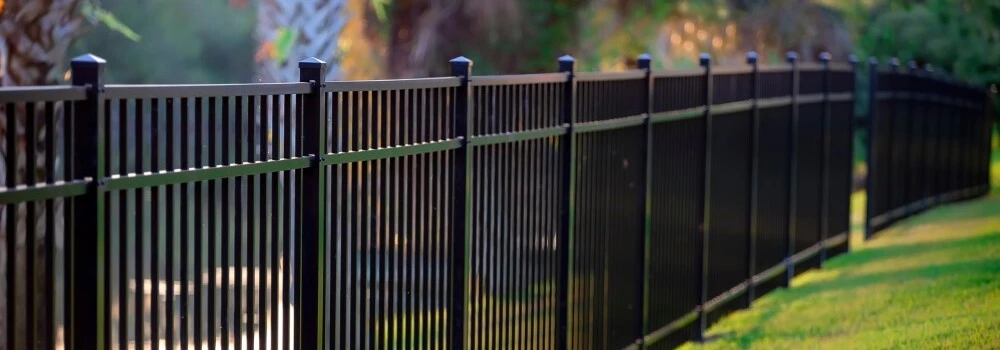
Horizontal wood fence design is a hit
Horizontal wood fence design has been increasing in popularity lately. People are drawn to its sleek, modern look and the differentiators between a vertical fence and a horizontal fence.
Horizontal fences have both advantages and disadvantages, which we will explore further in this blog post. Whether you are looking for garden fence ideas or want to know all about fences, we have you covered!
Differentiators between a vertical fence and a horizontal fence
One of the most common questions we get asked is what differentiates a horizontal fence from a vertical fence. The answer is in the construction.
A horizontal fence has its pickets installed horizontally, while a vertical fence has its pickets installed vertically. That means instead of vertical boards, you have horizontal boards stacked one atop the other. Both fence types have similar fence post layouts, as both need these for support.
Horizontal fences: advantages and disadvantages
If you’re considering adding a horizontal fence to your property, you should take time to ponder the benefits as well as any potential downsides. That’s just being a savvy consumer!
Vertical fences are the more traditional choice, but as horizontal fences increase in popularity, they are becoming much more common. Here’s what you should know!
Advantages
People are drawn to horizontal fences for their sleek look. They can provide privacy without feeling too heavy or closed off and they allow you to show off your landscaping.
Horizontal fences are great for smaller spaces because the length of the boards stretching from side to side gives the impression and illusion of space. This is great for garden fencing and patio dining areas.
Disadvantages
However, horizontal fences do have a couple of downsides. They can be more expensive than vertical fences because they require more lumber.
Additionally, horizontal fences are more likely to sag over time due to the weight of the pickets pulling down on the posts. This is more of an issue for taller fences versus those that use less lumber.
Luckily, the drooping or sagging can be counteracted by using high-quality materials and hiring an experienced fencing company to handle the installation. Then you have nothing to worry about!
All about fences: fence panels and fence posts
There are two main types of fence panels: horizontal and vertical. Vertical fences have panels that are lined up next to each other, whereas horizontal fences have horizontal boards.
Fence panels
The panels themselves can come in a variety of sizes and heights and can be made out of various materials. They can also have a variety of finishes. These are also referred to as fence boards.
Fence posts
Fence posts are made from either wood, metal, or plastic. Metal fence posts are the most durable but they can be the most expensive.
Wood fence posts are the least expensive but they may not last as long as metal fence posts. Plastic fence posts are a middle ground in terms of price and durability.
Fence rails
Fence rails are generally two-by-fours that are installed between or across posts and are often what the fence boards are affixed to. All vertical fences will have a top and bottom rail.
Rails for horizontal fencing help add extra durability for the panels in-between the fence posts. Unlike other fencing styles though, rails are hidden on horizontal fencing as they become incorporated into the overall look of the fence.
Fence ideas for flair and function
A key aspect of landscaping a garden is that fencing can help protect your backyard from wildlife invaders. Fences can also add privacy or define yard space. With horizontal wood fence design, you can combine function with plenty of flair!
For example, a slatted horizontal wood fence is perfect for modern patios. If you have garden fencing ideas that include planting flowers, a horizontal fence can provide a dramatic backdrop.
You can also mix woven, slatted, and solid fencing in your horizontal wood fence design to create an interesting contrast. The idea is to be creative and unorthodox with your fence construction for the most dramatic -but still useful- effect.
A slatted wooden fence for modern patios
If you’re looking for a horizontal wood fence design with a modern twist, try using slatted fencing instead of solid panels. Slatted fencing adds visual interest and can be used to create a dramatic backdrop for planting flowers or as a boundary between different areas of your yard.
What this means is that there are open spaces between the fence boards. Instead of having the fence boards stacked tightly against each other, they are spread out. This is visually appealing. It gives an airy feel and allows for more visibility, which can be helpful in a variety of settings.
Garden fence ideas for boundaries
If you’re looking for garden fence ideas, horizontal wood fences are a great option. They can provide privacy without feeling too heavy or closed off and they allow you to show off your landscaping. You can also mix slatted and solid fencing in your horizontal wood fence design to create interest.
One of the huge benefits of how horizontal fences work is that height is determined by how many fence boards are stacked. Therefore, it is much easier to customize height than it is with vertical fences.
Garden fencing is often shorter (think of a short picket fence) since you don’t necessarily need privacy, just some protection and boundaries. Thus, horizontal fences work perfectly for this purpose!
Juxtapose a neutral fence with a flash of color
For a horizontal wood fence design that is both stylish and unique, try juxtaposing a neutral fence with a flash of color. This can be done by painting the posts or adding decorative elements like planters.
Instead of leaving your wood fence in its natural state, you can stain it or paint it. Doing so just as an accent adds interest and variety to your property. In outdoor spaces like gardens, the brighter the better! Think yellows, lime greens, or deep pinks.
Give your fence the feature wall treatment
Another way to dress up your horizontal wood fence design is to give it the feature wall treatment. This can be done by painting the fence a bold color or hanging things on the panels.
For example, some creative homeowners have created outdoor gallery walls on their horizontal fences! You can hang artwork or planters, or even lights. Anything to draw the eye to the main feature – your gorgeous new fence.
Other design ideas
There are plenty of other design ideas to make your fence stand out. For example, a popular option with horizontal fences is to alternate the width of the panels. This layering creates a pattern, especially coupled with some open space, that is very visually appealing.
Another option for a sleek finish is to only feature fence posts on one side of the fence. If only one side of the fence is typically visible, you can create an ultra-streamlined look.
Because horizontal fences are so versatile in their construction, you can get really unique. You can offset boards horizontally, not just vertically, to create windows. These are like little pockets of visual appeal!
Building a fence the right way
Now that we’ve gone over some horizontal wood fence design ideas, let’s talk about how to construct a horizontal fence. As we noted, to prevent potential sagging, you’re probably best off hiring a professional for installation. What you save in labor costs can cost you later in repairs!
But if you plan to DIY it or you are simply curious, we’ll walk you through the installation steps.
Fencing materials
The first thing you’ll need to do is gather your materials. You’ll need posts, post caps, pickets, rails, and hardware. And as always make sure you don’t cheap out – good materials make for a durable fence.
Prepping the ground
Next, you’ll need to dig holes for your posts. The depth of the holes will depend on the height of your fence. Once the holes are dug, you can set the posts in place and fill them with concrete.
Uneven ground can be a challenge with horizontal fencing, so if this is an issue, you may need to do some extensive ground clearing first. Alternatively, if you have uneven ground you can opt for a stepped look. This is actually a popular option that looks better with a horizontally oriented board than a vertical one.
Adding pickets and fencing panels
Once the posts are set, you can attach the pickets. For a horizontal wood fence design, the pickets can be attached either horizontally or vertically.
Once all of the pickets are in place, you can add the rails. The rails should be placed so that they are evenly spaced between the posts.
Hardware
Finally, you can install the hardware. This includes brackets, screws, and nails. Once everything is in place, your horizontal wood fence design is complete!
Finishing touches
This includes any painting, staining, or other embellishments. The options are endless!
Is wood the only option for horizontal fencing?
Not at all! While wood is the most popular and affordable option, you can design a fence with whatever materials you like.
Metal
You may see contemporary homes that feature metal horizontal fences. They love the clean lines and contemporary look of the horizontal boards but want a “fresher” material. Metal fence posts are the most durable but they can be the most expensive.
Vinyl (PVC)
Other people prefer the durability and low maintenance appeal of vinyl. Vinyl (PVC)fence posts are a middle ground in terms of price but they offer great durability.
Wood
Wood is classic – eternally popular, affordable, and versatile. Wood fence posts are the least expensive but they may not last as long as metal or vinyl fences.
Maintaining a horizontal fence
Once your horizontal wood fence design is complete, it is important to maintain it so that it will last for years to come. Inspect the fence regularly for damage and make repairs as needed.
Wood fences can last and look beautiful for many years, but they do require maintenance. Also, be sure to check the hardware periodically to make sure that it is tight and secure and not rusting.
Getting started on your horizontal wood fence design
Now that you know all about horizontal wood fences, you’re ready to start planning your own design! Use the tips and ideas we’ve shared in this post to create a beautiful and functional horizontal wood fence for your home.
Horizontal wood fence designs are a great way to add privacy and style to your home. There are many different ways you can design a horizontal wood fence, and the options are endless.
Choosing Bravo Fence Company
Whether you’re looking for a modern twist or a traditional boundary, horizontal wood fences are a great choice. And Bravo Fence Company can help!
We have extensive experience and connections within the industry, which translates to great prices and better quality for our customers. And we pride ourselves on our superior service.
If you have any questions, feel free to reach out to the pros at Bravo Fence Company. We hope this post has inspired you to start planning your own horizontal wood fence design, and we can’t wait to help you design the custom fence of your dreams. Happy fencing!

